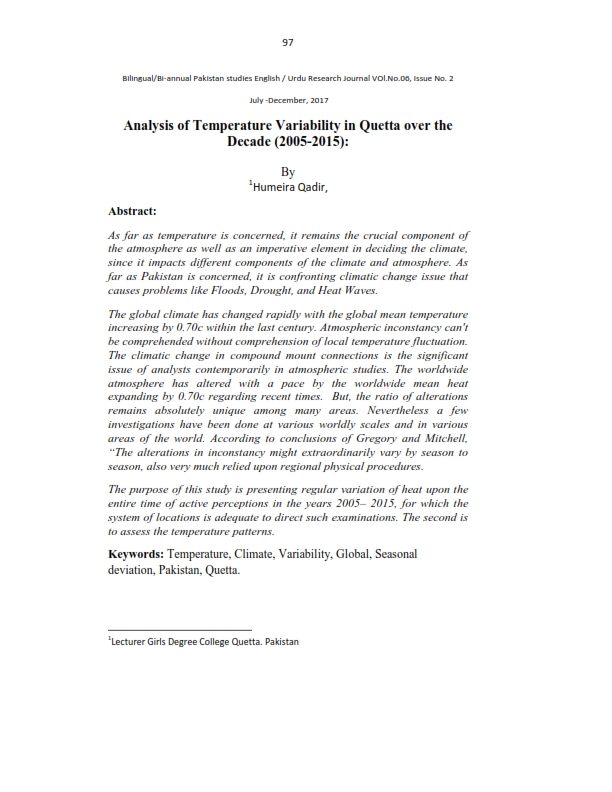Analysis of Temperature Variability in Quetta over the Decade (2005-2015)
Keywords:
Temperature, Climate, Variability, Global, Seasonal deviation, Pakistan, Quetta.Abstract
As far as temperature is concerned, it remains the crucial component of
the atmosphere as well as an imperative element in deciding the climate,
since it impacts different components of the climate and atmosphere. As
far as Pakistan is concerned, it is confronting climatic change issue that
causes problems like Floods, Drought, and Heat Waves.
The global climate has changed rapidly with the global mean temperature
increasing by 0.70c within the last century. Atmospheric inconstancy can't
be comprehended without comprehension of local temperature fluctuation.
The climatic change in compound mount connections is the significant
issue of analysts contemporarily in atmospheric studies. The worldwide
atmosphere has altered with a pace by the worldwide mean heat
expanding by 0.70c regarding recent times. But, the ratio of alterations
remains absolutely unique among many areas. Nevertheless a few
investigations have been done at various worldly scales and in various
areas of the world. According to conclusions of Gregory and Mitchell,
“The alterations in inconstancy might extraordinarily vary by season to
season, also very much relied upon regional physical procedures.
The purpose of this study is presenting regular variation of heat upon the
entire time of active perceptions in the years 2005– 2015, for which the
system of locations is adequate to direct such examinations. The second is
to assess the temperature patterns.
References
change and greenhouse gases, background information for AGU
(American Geophysical Union), Position Statement,EOS, 80(39), p 453
Deming, W. E. (1982). Quality, productivity and competitive position.
MIT Centre for Advanced Engineering Study: Cambridge. MA.
Department for international development (July 2014). A DFID
literature review: What is the evidence on the impact of research on
international development? Version 1.1
Hair, J. F., Wolfinbarger, M. F., Ortinau, D. J. & Bush, R. P. (2010).
Essentials of Marketing Research (2nd ed.). McGraw-Hill, United
Kingdom.
Houghton J. T., Y. Ding, D. J. Griggs, M. Noguer, P. J. V. Der Linden,
Xioaosu D (eds). 1995. Climate Change 1995: The Scientific Basis,
Contribution of Working Group I to the Third Assessment Report of the
Intergovernmental Panel on Climate Change. Cambridge University
Press: Cambridge.
Iftikhar Ahmad, Sun Zhaobo, RomanaAmbreen, Yu Miao. 2011. Trend
Analysis of July Temperature in Pakistan with Emphasis on its Spatial
Distribution, Pakistan Geographic Review, 1 & 2 (66).1-12.
Iftikhar AHMAD, RomanaAmbreen, Shahzad Sultan, SUN Zhaobo,
Deng Weitao, 2014. Spatial-temporal Variations in January
Temperature in Pakistan: A Geographical Approach. Atmospheric and
Climate Sciences 4, 524-533.
Iftikhar AHMAD, RomanaAmbreen, Shahzad Sultan, SUN Zhaobo,
Deng Weitao, 2014. Spatial-temporal Variations in January
Temperature in Pakistan and their Possible Links with SLP and 500-hPa
Jonathan, T. (2000): Growth Effects of Education and Social Capital in
the OECD, mimeo, paper prepared for the OECD.
Laws, S., Harper, C., Jones, N., & Marcus, R. (2013). Research for
development, (2nd ed.) a practical guide sage publication
Liu X, Chen B, 2000: Climatic warming in the Tibetan Plateau during
recent decades. International Journal of Climatology, 20. 1729-1742.
Magnuson J, et al., 2000: Historical trends in lake and river ice cover in
the Northern Hemisphere. Science, 289. 1743-1746.
Mitra, A.P. (2002) Climate in South Asia and water resources, A Draft
Article Circulated in Internet Among the APN South Asia Water and
Climate Change Study Team Members, New Delhi, India
Nunn, N. (2008). The long-term effects of Africa’s slave trades. The
Quarterly Journal of Economics, Harvard College and the
Massachusetts Institute ofTechnology.
Nicol, J F, Raja I A, Allaudin A., Jamy G N, 1999: Climatic variations
in comfortable temperatures: the Pakistan projects. Energy and
Buildings, 30, 261–279.
Oguntunde, P. G., Abiodun, B. J., Gunnar L. (2012).Spatial and
temporal temperature trends in Nigeria, 1901–2000. Meteorology and
Atmospheric Physics118:95–105.
Ozturk, I. (2001). The role of education in economic development: a
theoretical perspective. Journal of Rural Development and
Administration, 33 (1), 39-47. 1
Palmer, T. (2012). The Importance of Economic Growth. Certified
public accounts.
Pachauri, RK. (2009) Regional Conference on “Climate Change:
Challenges and Opportunities for South Asia”, 13-14 January 2009,
Islamabad.
Qian, W. and Qin, A. 2006. Spatial-temporal characteristics of
temperature variation in China. MeteorologyAtmos. Phys. 93: 1-16
Robert, T. (1999). Labor Markets and Economic Growth, in: O. C.
Ashenfelter and D. Card (eds.): Handbook of Labor Economics, Vol.
C, North-Holland, Amsterdam
Robot, C. (2013). The influence of organizational culture and teamwork
on employee performance at PT. Bank Sulut, TBK. Journal EMBA, 1
(4), 1358-1364
Robert, A., Brown and N. J. Rosenberg, 1999: Climate Change Impacts
on the Potential Productivity of Corn and Winter Wheat in Their
Primary United States Growing Regions, Climate Change, 41(1) 73-
Rasul, Ghulam, QIN Dahe, Chaudhry Q. Z. 2008: Global warming and
melting glaciers along southern slopes of HKH Ranges; Pakistan
Journal of Meteorology Vol.5, No.1, pp.63-76.
Rahmstorf, S. (2007) A semi-empirical approach to projecting future
sea-level rise. Science, 315(5810), 368-370.
Sekaran , U. and Bougie, R. (2009). Research Methods for Business
(5th ed.). Wiley, Americas: New York
Saunders, M., Lewis, P., &Thornhill, A. (2009). Research methods for
business students, (5th ed.). Essex: Pearson Education Limited.
Sen, A. K. (2005), Human Rights and Capabilities. Journal of Human
Development, 6(2):151-66.
Winkle, M. A., Kraemer, H. C., Ahn, D. K. &Varady, A. N. (1998).
Ethnic and Socioeconomic Differences in Cardiovascular Disease Risk
Factors. Findings for Women From the Third National Health and
Nutrition Examination Survey, 280, (4).



